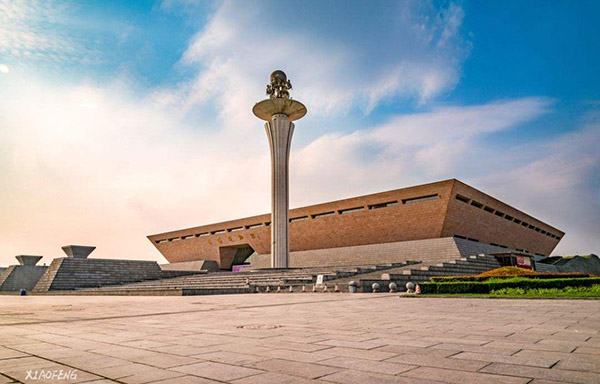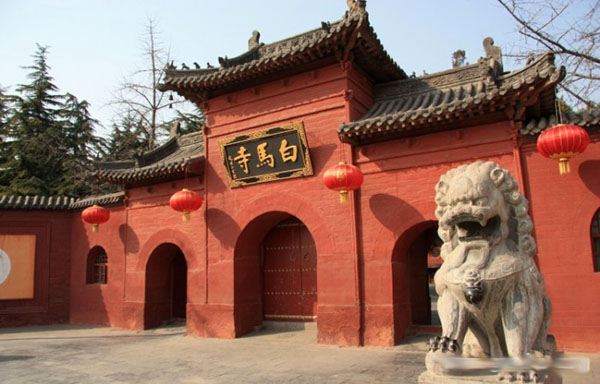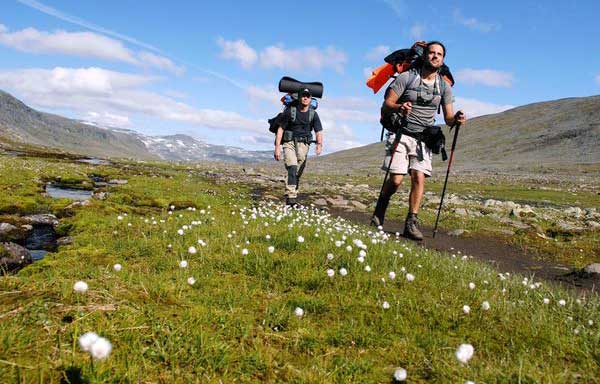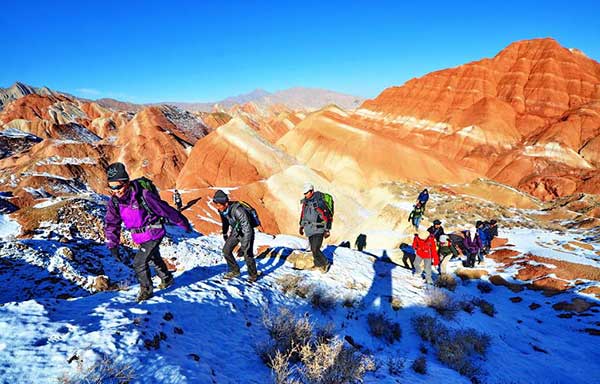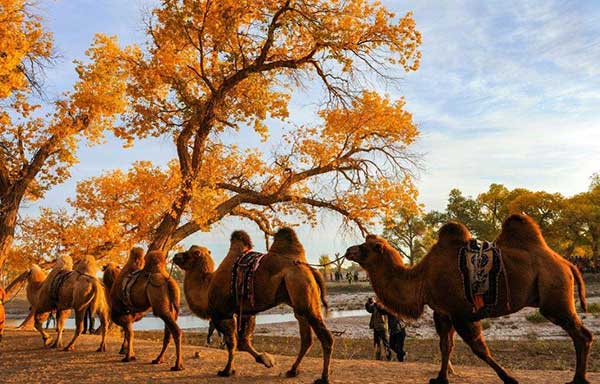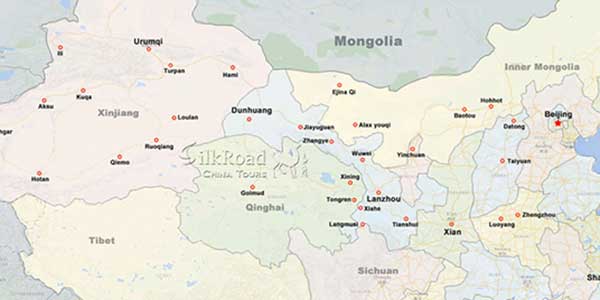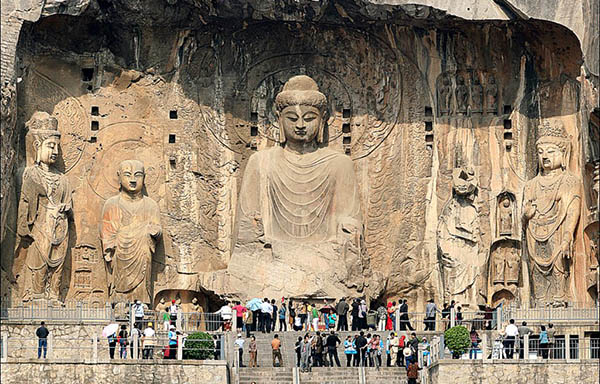 Longmen Grottoes carved on the Longmen and Xiangshan Mountain on the both sides of Yi River to the south of Luoyang City. It’s one of the important stone sculpture treasure house of China and together with Mogao Grottoes in Dunhuang and the Yungang Grottoes in Datong enjoy fame as the three greatest grottoes of China. The construction of Longmen Grottoes started in Northern Wei dynasty ( Xiaowen Emperor Period ) and lasted for 500 years from Northern Wei to Eastern Wei, Western Wei, Northern Qi, Sui, Tang, Five Dynasties and Song, which comprise more than 2,300 caves and niches carved into the steep limestone cliffs over a 1km long stretch. These contain almost 110,000 Buddhist stone statues, more than 60 stupas and 2,800 inscriptions carved on steles.
Longmen Grottoes carved on the Longmen and Xiangshan Mountain on the both sides of Yi River to the south of Luoyang City. It’s one of the important stone sculpture treasure house of China and together with Mogao Grottoes in Dunhuang and the Yungang Grottoes in Datong enjoy fame as the three greatest grottoes of China. The construction of Longmen Grottoes started in Northern Wei dynasty ( Xiaowen Emperor Period ) and lasted for 500 years from Northern Wei to Eastern Wei, Western Wei, Northern Qi, Sui, Tang, Five Dynasties and Song, which comprise more than 2,300 caves and niches carved into the steep limestone cliffs over a 1km long stretch. These contain almost 110,000 Buddhist stone statues, more than 60 stupas and 2,800 inscriptions carved on steles.
Longmen Grottoes has long history and spans many dynasties, with plenty of painting and text information well reflects the different aspects of the development and changes of ancient Chinese political, economic, religious, cultural and many other fields. In 2000, Longmen Grottoes was listed as the World Cultural heritage site by UNESCO.
History of the Longmen Grottoes
the carvings of the Longmen Grottoes were commissioned by emperors, members of the imperial family and other wealthy families, generals, and religious groups, all who hoped to earn good fortune through their donations.
The site was "founded" by the Northern Wei dynasty in 492 AD, when they moved their capital to Luoyang from Datong (where they had carved the Yungang Caves). Three sets of caves - Guyang, Bingyang and Lianhua - date from this early period. Their art was similar to that at Datong but was adapted to the harder limestone surface of the Longmen Caves. Work continued under various patrons for 500 years and reached a second peak under the Tang, particularly under the devoted Buddhist Empress Wu Zetian.
The caves have suffered from significant vandalism and looting over the years, beginning with the anti-Buddhist movement of the 9th century. Destruction continued at the hands of souvenir-hunting Westerners in the 19th and 20th centuries, and culminated in attacks by Red Guards during the Cultural Revolution.
What to See at the Longmen Cave
The three Bingyang caves are among the earliest, carved by the Northern Wei in the Datong style. The middle Bingyang cave was commissioned by Emperor Xuan Wu to honor his parents and is said to have taken 800,000 men working from 500 to 523 AD to complete. The 11 statues of the Buddha show northern characteristics (long features, thin faces, fishtail robes) and traces of Greek influence. The side caves, completed under the Tang, are more natural and voluptuous in style.
Wanfo or Wan Fo Dong (Cave of Ten Thousand Buddhas), just south, was built in 680 by Gao Zong and his empress Wu Zetian. It has 15,000 Buddhas carved in tiny niches, each one different. The smallest is just 2cm high. Another early cave is Lianhua (Lotus Flower Cave), dating from 527 and named for the beautifully carved lotus decorating its roof.
Fengxian or Feng Xian Si (Ancestor Worshipping Cave), carved between 672 and 675 for Empress Wu Zetian, is the largest and most splendid of all the caves and considered the culmination of Tang carving. The monumental shrine has a square plan measuring about 30m (100 feet) on each side. It centers on a majestic seated figure of Vairocana Buddha on the back wall, 17m (56ft) high with 2m-long ears. On his left, a Bodhisattva wears a crown and pearls and a divine general treads an evil spirit underfoot.
Inscriptions in the Medical Prescription Cave, dating from 575, detail hundreds of cures for everything from madness to the common cold. Some of the prescriptions are still used today.
Further on is Guyang, the oldest cave at Longmen, begun in 495. It still has some traces of the paint that originally gave life to the carvings. There is a central Buddha and three tiers of niches on the northern and southern walls, which contain hundreds of statues. Most of the statues are engraved with the names of the artists, the dates and the reasons for carving them. There are also nineteen of the "Twenty Pieces," important examples of ancient calligraphy.
From the end of the west bank, a bridge leads to the east bank for a fine view of the caves. Up the hill is the Tomb of Bai Juyi, the famous Tang poet, who spent his last years in Luoyang as the Retired Scholar of the Fragrant Hill.
Gallery
Attractions in the area
Related Tours
General Information
Alias: Longmen Caves
Loc: 12 km from Luoyang
Entrance: 120 RMB
Open Time: 8:30 - 5:30
Relevant blogs
-
How did the name of Tianshui in Gansu come about?
The name Tianshui is very pleasant to the ear, and it reminds one of that exquisitely beautiful verse, "After getting drunk, one doesn't know if the sky is in
-
The 8th Silk Road Hotel Festival was successfully held i
On December 27th, the "8th Silk Road Hotel Festival" grandly opened at the Yujing International Hotel in Zhangye. This hotel festival gathered industry experts,
-
The Karez Irrigation System in Turpan has been selected
On September 3rd, at the 75th Executive Council Meeting of the International Commission on Irrigation and Drainage held in Sydney, Australia, the 2024 (11th bat
-
What is the connection between "dragons" and "snakes
In traditional Chinese culture, the snake has a dual identity of auspiciousness and danger. Ancient people believed that the snake not only possesses divine cha
-
Endangered Przewalski's Horses Spotted at Dunhuang Yume
<p>In early February, a group of special "visitors"—the Przewalski's horses—appeared at the Dunhuang Yumen Pass scenic area in Gansu Province, a U
-
The Fourth Dunhuang Cultural Tourism Supplier Conference
On the morning of February 18th, the Fourth Dunhuang Cultural Tourism Supplier Conference in Northwest China commenced at the Dunhuang International Convention







